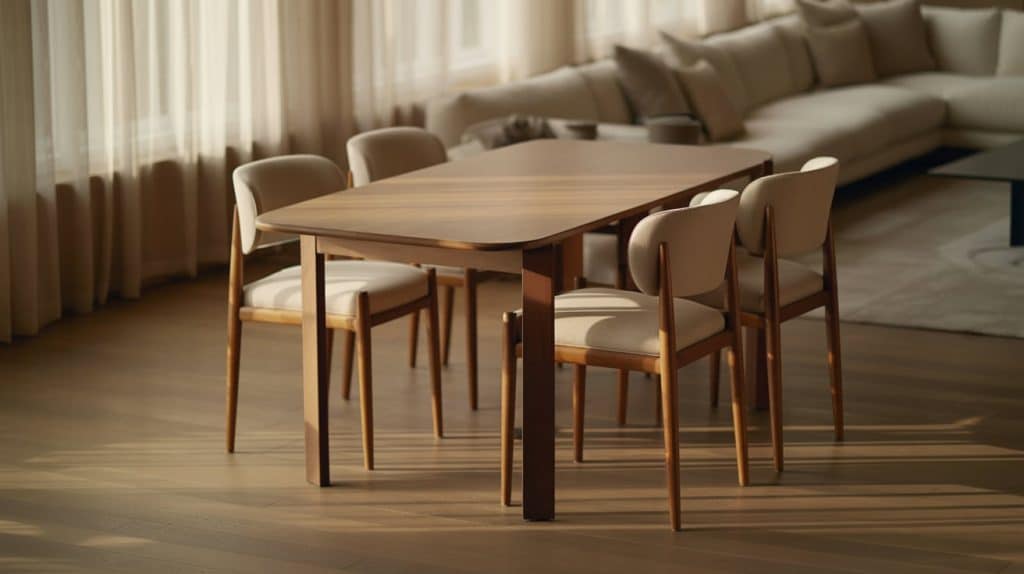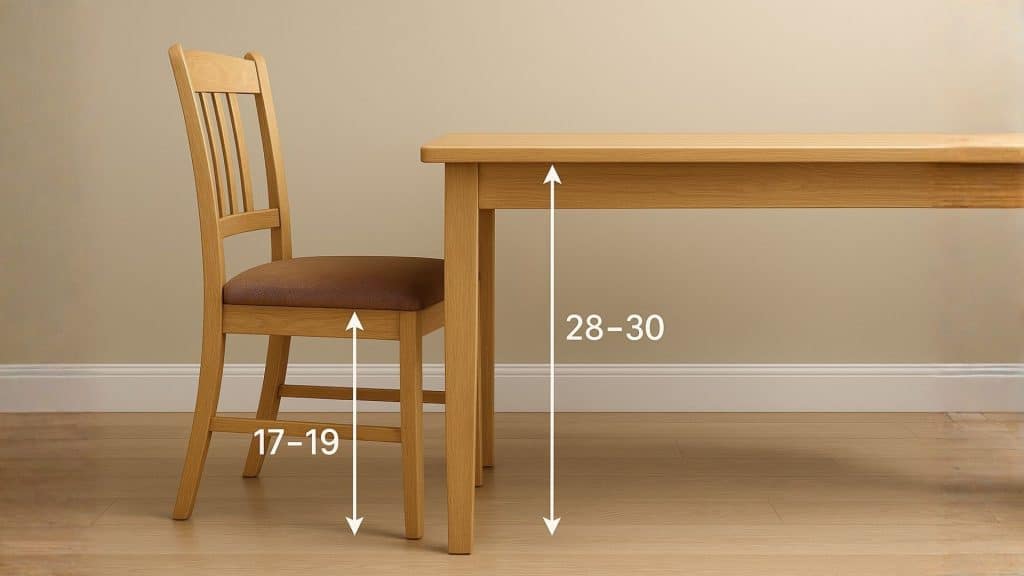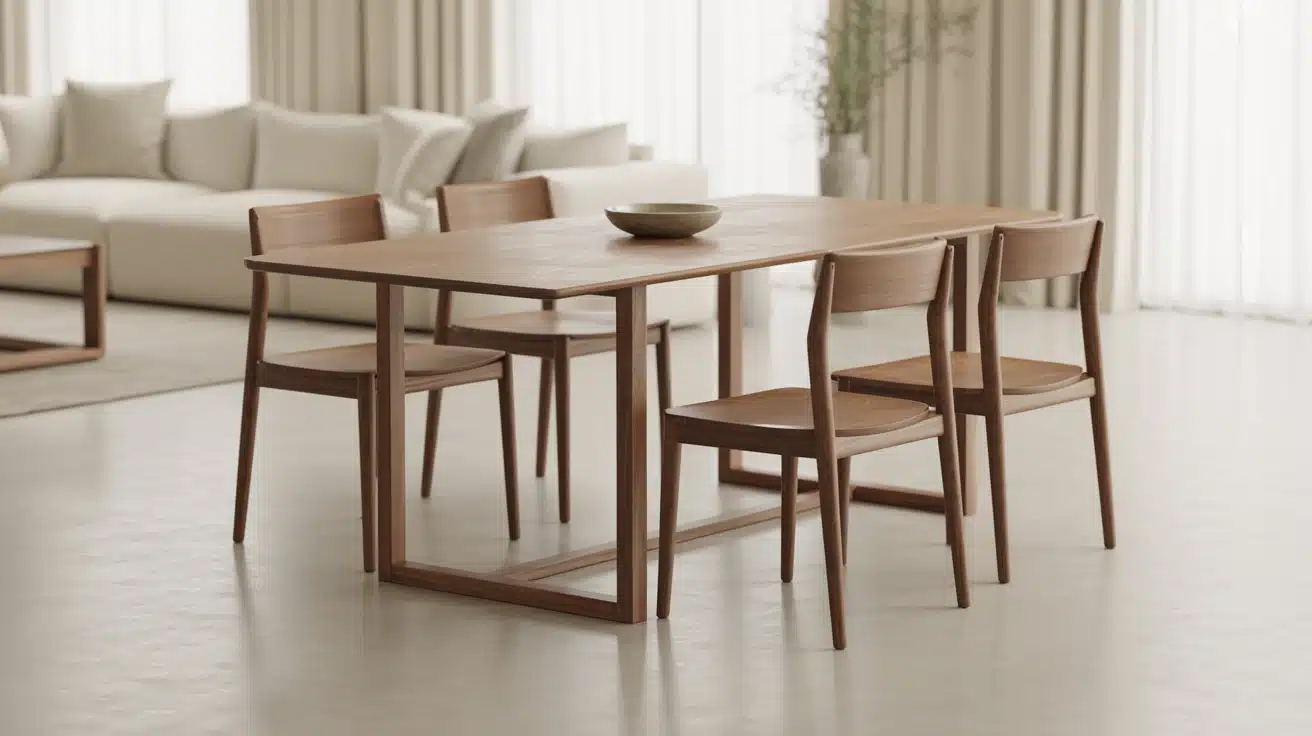Ever pulled up a chair to a table and felt instantly uncomfortable?
Your knees hit the underside. Your shoulders hunch forward. Your feet dangle awkwardly.
The problem isn’t you, it’s the table height. Most people never think about table height until they’re stuck at the wrong one.
But here’s the thing: standard table height exists for good reasons. It’s based on how the human body sits and moves. Getting this measurement right makes every meal more comfortable.
This guide breaks down everything you need to know about standard dining table height. You’ll learn the exact measurements, why they matter, and how to choose the perfect height for your space.
What is the Standard Dining Table Height?
Most dining tables stand between 28 to 30 inches tall. This measurement goes from the floor to the top of the table surface. In metric terms, that’s 71 to 76 centimeters. You’ll find this height in almost every furniture store.
This range has been the standard for decades. Nearly all dining tables fall within these measurements. Manufacturers design chairs to match this exact height. It’s not just a suggestion, it’s an industry standard.
When you shop for a dining table, expect to see this height everywhere. Whether you’re looking at modern designs or traditional styles, the height stays the same.
Why This Height Works?

The 28-30-inch range isn’t chosen randomly. It’s based on how people sit comfortably at a table.
- Comfort is the main reason. When you sit at a standard-height table, your body relaxes. Your arms rest at the right angle. Your elbows bend at about 90 degrees. You won’t hunch your shoulders or strain your back.
- Your feet stay grounded. Standard table height means your feet touch the floor. No dangling legs. No circulation problems. Sit with dangling feet for 20 minutes, and you’ll feel the discomfort.
- Standard chairs match perfectly. Most dining chairs sit 17 to 19 inches high. This creates 10 to 12 inches of clearance. Your legs fit comfortably without hitting the tabletop or apron.
- The room looks balanced. A table at standard height doesn’t overpower your space. It sits at the right level for good proportions. Everything feels natural, not too big or too small.
The visual balance matters. Interior designers call this “scale and proportion.” When you walk into a room, the table should feel natural. Not like furniture from a dollhouse or a giant’s castle.
How to Match Chairs & Check Clearance?

Getting the right chair-to-table fit makes all the difference. You don’t want chairs that are too high or too low. You need the right measurements to sit comfortably for hours.
1. Chair Seat Height
For a 28-30-inch table, your chair seats should be around 17 to 19 inches high.
This is measured from the floor to the top of the seat. Most standard dining chairs fall in this range.
When you pair them with a standard table, everything lines up perfectly. Your arms rest naturally on the table without reaching up or down.
2. The Gap Between Seat and Tabletop
Leave about 10 to 12 inches of space between the chair seat and the bottom of the table. This is your legroom. Without enough space, your thighs hit the table or apron.
That gets uncomfortable fast. With proper clearance, you can sit, shift position, and cross your legs if needed. This gap is measured in centimeters, ranging from 25 to 30 cm.
3. Tabletop Thickness and Apron Design
The thickness of your tabletop matters more than you think. A thick tabletop or a wide apron reduces your actual legroom. Check the underside of the table before you buy.
Some tables have decorative aprons that look great but steal inches from your clearance. Measure from the chair seat to the lowest point under the table, not just the tabletop.
4. Check Armrest Clearance
If your chairs have arms, test them before buying. The armrests need to slide under the table without hitting the apron or tabletop. Push the chair in all the way.
If the arms catch, you’ll end up with chairs sticking out awkwardly. This makes your dining area feel cramped and look messy.
But what if the standard 28-30 inch height doesn’t work for your space or needs? Some situations call for tables that sit higher or lower than the norm.
Variations: When You Go Above or Below “Standard”
Standard dining tables work for most homes. But they’re not your only option. Some spaces and styles call for different heights.
Taller tables create a different vibe. They’re popular in open kitchens and entertainment areas.
| Table Type | Height Range | Best Seating | Best For |
|---|---|---|---|
| Standard Dining | 28-30 inches (71-76 cm) | Standard dining chairs (17-19″ seat height) | Formal dining rooms, family meals, traditional settings |
| Counter-Height | 34-36 inches (86-91 cm) | Counter-height chairs or stools (24-26″ seat height) | Kitchen islands, breakfast nooks, casual dining |
| Bar-Height | 40-42 inches (102-107 cm) | Bar stools (28-30″ seat height) | Home bars, café-style spaces, social gatherings |
Counter-height tables match your kitchen counter. At 34 to 36 inches, they blend into open-concept layouts.
Pair them with stools that have 24 to 26-inch seat heights. Many homeowners choose these for breakfast nooks or kitchen islands.
Bar-height tables are 40 to 42 inches high. You’ll find them in pubs and cafés. They encourage standing conversations and quick meals.
Use bar stools with 28 to 30-inch seats. These tables aren’t practical for long dinners or families with young children.
How to Choose the Right Height for Your Space?
Picking the right table height goes beyond standard measurements. Your specific space and needs matter more than blindly following rules.
|
Use this simple formula Table height – Chair seat height = 10 to 12 inches of clearance. This ensures comfort no matter which height you choose. |
- Measure your space first: Check the distance from the floor to the ceiling. Measure the room’s length and width. Count how many people will regularly sit at the table. A table that’s too tall makes a room with low ceilings feel cramped. A small room needs careful planning to avoid a crowded feel.
- Test with actual chairs: Measure the seat height of chairs you plan to use. Sit at a table of similar height if possible. Does your posture feel natural? Can you rest your arms without lifting your shoulders? This test reveals problems before you buy.
- Think about who sits there: Do you have tall family members over 6 feet tall? They need more legroom. Young children struggle with counter-height tables. If the table doubles as a workspace for homework or laptops, standard height works better than bar height.
- Consider visual balance: Look at the table’s leg design and apron thickness. A chunky apron on a thick tabletop reduces actual legroom. The table’s height changes how the room feels. A tall table in a small space makes everything feel tight. A low table in a large room can look lost.
- Plan for movement space: Leave at least 36 inches behind each chair for people to pull out and sit down. Add 42 to 48 inches if it’s a walkway behind the chairs. Measure the path from the kitchen to the table. You need room to carry dishes without squeezing past chairs.
Conclusion
Standard table height isn’t complicated. Most dining tables are 28 to 30 inches high.
This works with standard chairs and keeps you comfortable during meals. But your specific needs matter too. Measure your space.
Test different heights. Think about who uses the table daily. Counter-height and bar-height tables offer alternatives for casual settings.
The right table height makes your dining area more functional and comfortable. Now that you know the measurements and principles, you can shop with confidence.
Take a tape measure when you shop for furniture. Sit at tables before buying.
Your back and knees will thank you. What’s your current table height? Does it work for your family, or is it time for a change?


